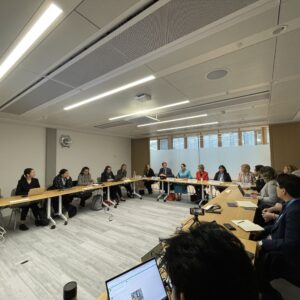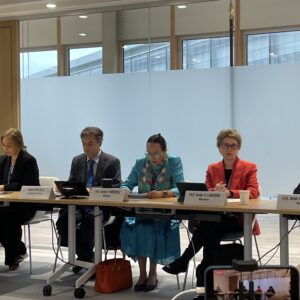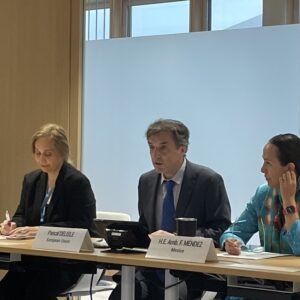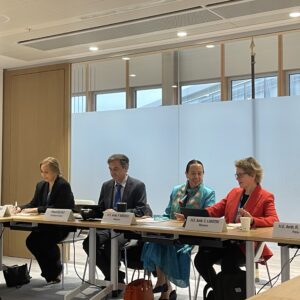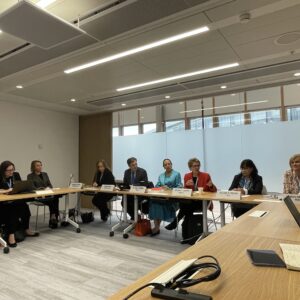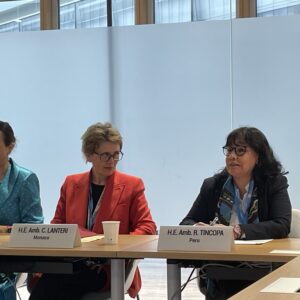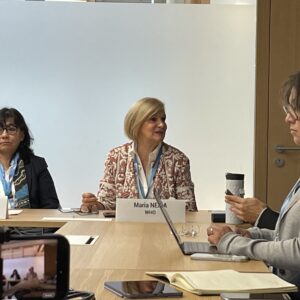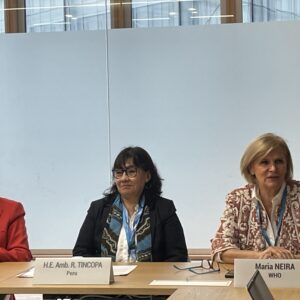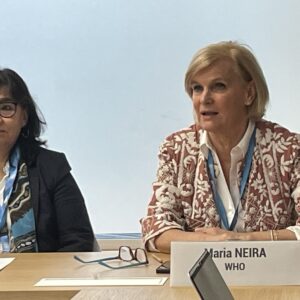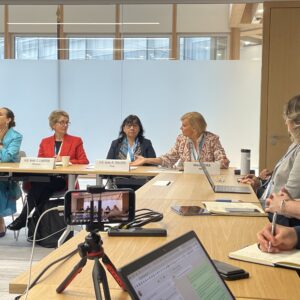Event Conference
The Impact of Chemicals, Waste, and Pollution on Human Health

25 May 2023
08:00–09:00
Venue: Palais des Nations, Room H-307-1 & Online | Webex
On the sidelines of the 76th Session of the World Health Assembly (WHA76), this event discussed the links between the impacts of chemicals, waste and pollution, the protection of human health, and the importance of a draft resolution tabled by Peru, Canada, Colombia, Ecuador, El Salvador, Mexico, Monaco, Switzerland, Uruguay, and the European Union and its Member States.

About this Session
At the Seventy-sixth World Health Assembly (WHA76) taking place in Geneva from 21 to 30 May 2023, a draft resolution on the impact of chemicals, waste, and pollution on human health is tabled by Peru, Canada, Colombia, Ecuador, El Salvador, Mexico, Monaco, Switzerland, Uruguay, and the European Union and its Member States. The draft resolution, available on the WHA76 portal, includes notes and references to various ongoing negotiations as well as UN Environment Assembly and Human Rights Council resolutions. Among these:
- Plastic pollution and the Intergovernmental Negotiating Committee in charge of developing a legally binding instrument on plastic pollution | Scaling-up work on plastics and health. Indeed its impacts are not given adequate attention as stated by WHO Director-General Dr. Tedros Adhanom Ghebreyesus during the Geneva Day held at the World Economic Forum 2023.
- The Strategic Approach and sound management of chemicals and waste beyond 2020 (SAICM) and the inter-sessional work of the International Conference on Chemicals Management.
- State of the Science of Endocrine Disrupting Chemicals | Update of the UNEP report to be prepared prior to the sixth session of the United Nations Environment Assembly, in line with the resolution UNEA 5/7.
- Ad Hoc Open-Ended Working Group to establish a Science-Policy Panel to contribute further to the sound management of chemicals and waste and to prevent pollution | Contribute to the work of OEWG, and explore the full range of options for the future involvement of WHO for the consideration at the next WHA.
- Inter-Organization Programme for the Sound Management of Chemicals (IOMC) | Further strengthening international cooperation and multi-sectoral engagement in the sound management of chemicals and waste.
On the sidelines of WHA76, this event discussed the links between the impacts of chemicals, waste and pollution, and the protection of human health.
Speakers
By order of intervention.

H.E. Amb. Francisca E. MÉNDEZ ESCOBAR
Permanent Representative of Mexico to the United Nations Office in Geneva
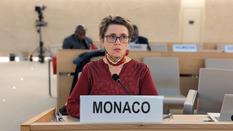
H.E. Amb. Carole LANTERI
Permanent Representative of the Principality of Monaco to the United Nations Office and other international organizations in Geneva
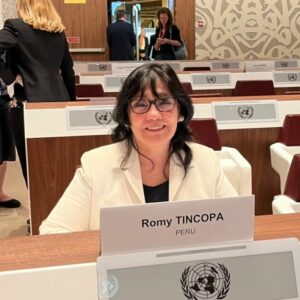
H.E. Amb. Romy TINCOPA
Deputy Permanent Representative of Peru to the international organizations in Geneva

Jacqueline ALVAREZ
Head, Chemicals and Health Branch, UNEP

Griffins OCHIENG
Executive Director, Centre for Environmental Justice and Development | Co-chair, IPEN Toxic Plastic Working Group

Maria NEIRA
Director, Department of Environment, Climate Change and Health, World Health Organization
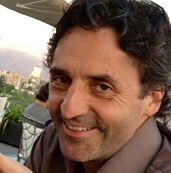
Pascal DELISLE
Head of Section, Economic, Environment, Development & Digital Affairs, EU Delegation to UN Office & other international organizations in Geneva | Moderator
Summary
Pascal DELISLE | Head of Section, Economic, Environment, Development & Digital Affairs, EU Delegation to UN Office & other international organizations in Geneva | Moderator
The aim of this event is to speak about the impact of chemical waste and pollution on human health, focusing on a draft resolution that in the context of the ongoing 76th World Health Assembly has been tabled by Peru, Canada, Colombia, Ecuador, El Salvador, Mexico, Monaco, Switzerland, Uruguay and the EU and all its member states. It includes references to ongoing processes and negotiations such as the UN Environment Assembly; the Human Rights Council; and more. It is important for this discussion to take place in Geneva, a hub for chemical and the headquarter of the Basel, Rotterdam, and Stockholm Conventions.
H.E. Amb. Francisca E. MÉNDEZ ESCOBAR | Permanent Representative of Mexico to the United Nations Office in Geneva
- In my opinion, this event is among the most important and timely ones within the context of the 76th World Health Assembly.
- Mexico promotes the One Health approach, which is connected to sustainability in terms of production and consumption and is all-encompassing to human activities.
- Mexico, as a part of the sponsoring countries, considers it is increasingly relevant to address one of the world’s most urgent problems: pollution and harm to human health and the environment from continued exposure to chemicals and wastes, which also contribute to the triple planetary crisis.
- Persistent organic pollutants (POPs) have been found in food; aquatic biota; high mountains; lakes; offshore waters and deep ocean trenches. Chemicals have even been detected in breast milk at alarming levels.
- These facts push us to take urgent action to tackle their harmful impacts. The proposed resolution is also the ideal framework to enhance the World Health Organization and the health sector’s engagement in current negotiations related to the Intergovernmental Negotiating Committee on Plastic Pollution; the Science-Policy Panel for Chemicals, Waste and Pollution; the Strategic Approach to International Chemicals Management (SAICM)’s Fifth session of the International Conference for Chemicals Management (ICCM5) and to continue the work with the framework of the Inter-Organization Programme for the Sound Management of Chemicals (IOMC) to encourage science-based review research regulation and contribution that we let the positive health and environmental impacts and to the achievement of many of the goals and targets of Agenda 2030.
H.E. Amb. Carole LANTERI | Permanent Representative of the Principality of Monaco to the United Nations Office and other international organizations in Geneva
- Monaco is engaged in forging international action on environmental issues and it is a sustainer of initiatives to address chemicals and plastic pollution and their effect on health.
- Monaco’s collaboration with WHO and the various resolution related to the health effects of pollution and climate change has been ongoing for various years.
- After supporting the past year’s various WHO resolutions on pollution and health, on climate change and health, this draft resolution is a connecting-all-the-dots type of resolution. It represents a roadmap for actions to be undertaken by countries to support WHO in scaling up work on plastics and health and requesting also some reports and to have WHO engaging in all processes.
- When the SDGs were adopted in 2015, requests for more horizontal management of issues were put forward. The chemical waste cluster is a good example of why a transversal approach and cooperation across fields are necessary.
- In March 2023, the Minderoo-Monaco Commission published a report on plastic and human health. This interdisciplinary work started in 2022 focuses on the effect of plastic materials throughout their life cycle on human health.
- The conclusions are quite dramatic. Plastics that are so helpful for our daily life are also a big threat because they contribute to diseases, disabilities; premature mortality at every stage of life and throughout its life cycle.
- These effects disproportionately affect vulnerable, low-income, and minority communities, with children being the most highly impacted group.
- The one-health approach is guiding us to radically change how we produce and consume plastics.
- This report and all scientific evidence on the adverse impact of plastics on humans and health should guide international negotiations.
H.E. Amb. Romy TINCOPA | Deputy Permanent Representative of Peru to the international organizations in Geneva
- This resolution and its sponsoring countries, Peru, Canada, Colombia, Ecuador, El Salvador, Mexico, Monaco, Switzerland, Uruguay, and the European Union and its Member States, pursue the objective of increasing the scientific knowledge on the human health impact of the chemical waste and pollution, included microplastics.
- This resolution is also instrumental in strengthening the linkage between the World Health Organization and the diverse platforms to address chemical and waste pollution such as UNEP SPP, SAICM and the Plastic Pollution INC, among others.
- We are aware that chemicals continue to be developed to satisfy growing demand. This leads to increasing and more complex pollution pathways.
- The majority of the world is affected as transported pollutants can travel long distances via wind, water, food chains and consumer product.
- In this context, the issue of microplastics is particularly relevant as it not only is ubiquitous in the environment, it has been found in food, organs and bloodstream.
- Applauding the International Community’s effort in taking action to address plastic pollution following the historic resolution adopted at the Fifth Session of the UN Environment Assembly (UNEP/PP/OEWG/1/INF/1), it is the aspiration of many delegations for the negotiated instrument to be firmly rooted in a human health approach.
- This WHA draft resolution is asking WHO to publish a report on the impact of chemical waste and pollution on human health from the One Health approach and to provide technical support to Member States, in particular developing countries same.
Jacqueline ALVAREZ | Head, Chemicals and Health Branch, UNEP
- This resolution represents both a thread among various environmental issues and their multifaceted interrelations with all domains of human life; and the highest level of ambition that is needed to adequately address these.
- The science and the numbers behind the chemical pollution crisis are becoming more and more preoccupying. Health threats like antimicrobial resistance are forecasted to be the cause of 10 million deaths per year, meaning that the whole population of my own country, Uruguay, could disappear three times a year.
- We have the scientific facts about how pollution is one of the main threats to our health, and we have a multilateral system in place to turn science into action.
- This structure must come into place and act quickly to change these worrying forecasts. The Beyond 2020 process for chemicals and waste is going to be adopted this year in September and it is critically necessary for it to bring its work health, labor, development, and food security innovation to its agenda.
- This resolution is timely and essential for changing the patterns and forecasts of pollution impact on human health and for forging the interlinkages among sectors against this challenge.
Griffins OCHIENG | Executive Director, Centre for Environmental Justice and Development | Co-chair, IPEN Toxic Plastic Working Group
- Highly hazardous pesticides (HHPs) and plastics are two major chemicals that have been contributing to the pollution crisis.
- HHPs are a global health problem, particularly because they result in deaths, suicides and high rates of accidental deaths, particularly in children.
- Fourteen million deaths have occurred from intentional self-poisoning since the beginning of the Green Revolution in the 1950s.
- Around 110 to 160 000 fatal pesticide self-poisonings occur every year.
- Eleven thousand intentional unintentional occupational poisonings occur every year and uncounted children die from exposure to pesticides particularly highly toxic pesticides.
- Environmental surveys have identified HHPs as one of the top six global contamination issues. This problem requires an immense amount of work and is being referenced and focused in the resolution.
- Bringing in the context of a developing country representative and organization in Africa, it is important to stress that the majority of aforementioned cases occur in low and middle-income countries.
- Africa is not a major producer of chemicals, pesticides or toxic substances that are used as additives in plastics but plastic pollution is a major problem in this part of the world.
- In discussions about food security, the argument that 20 to 40 percent of food would be lost without the use of pesticides is often used. We are able to produce food but this ends up not being healthy.
- Countries like Sri Lanka, Bangladesh or India have demonstrated that agriculture can do perfectly well without the most harmful pesticides. This shows that discourses on food security need to evolve and address concerns about human health impacts. This resolution is a useful instrument for putting this into perspective.
- Possible solutions can be tabled and adopted during the important meetings on the chemical’s international agenda, including the upcoming ICCM5. The Africa region has tabled a proposal to have a Global Alliance to face out HHPs. It is important that WHO also plays a part in contributing to this alliance and the adoption of this resolution will help to catalyze action to relevantly address HHPs, as the lead paint alliance achieved in limiting the issue of lead paint.
- The issue of plastic pollution is being discussed at various for and the world’s eyes are on the second session of the INC taking place in Paris next week. In the context of the 2023 Meeting of BRS Conventions Conferences of the Parties, IPEN presented a report that tested the number of consumer plastic products containing toxic chemicals, brominated flame retardants, among other substances regulated under the Stockholm convention. These are made from recycled materials or even e-waste, showing that if toxic chemicals are not removed from plastic production, recycling cannot be sustainable and safe.
- When negotiating or discussing plastic pollution, human health must occupy a central part. We need to end toxic pollutant production rather than just focusing on the pollution part, as these are responsible for the death of many across the globe.
Q & A
Valentina Sierra | Permanent Mission of Uruguay to the United Nations in Geneva
It is impressive how the health issue evolved in the chemical cluster considering the initial resistance encountered at UNEA-5.2, for instance, when we proposed to include language on the impact on human health. A group of countries decided to collaborate and support the language allowing it to be kept in the resolution. We are now at the beginning of the journey of connecting the dots of the different solutions to plastic pollution, which in turn will allow us to address gaps in the chemical cluster. In this context, establishing a science-policy panel is needed to elevate the third pillar of the triple planetary crisis, pollution. Although the scientific evidence provided by some of the reports presented today and beyond is undeniable, we still find resistance. Would it be possible in the WHO negotiations to mention or validate these reports, offering negotiators a stronger base and backup from the scientific Community?
Q: What will be the main challenge for this resolution approval and/or implementation? What role will WHO play in the many processes that deal with chemical waste and pollution?
H.E. Amb. Carole LANTERI | Resistance within WHO and to cross-cutting approaches remains the main issue. Within WHO, some countries’ representatives do not consider chemical pollution as part of the WHO mandate. On the other hand, bringing forward the health aspects in environmental discussions can be challenging for small countries, like Monaco, therefore coalition of countries is often the only avenue to progress. A horizontal versus vertical approach to these issues is needed to overcome this.
H.E. Amb. Francisca E. MÉNDEZ ESCOBAR | We need the right institutionalization across all processes at the UN system level, as well as national and regional levels, to channel the right commitments. This kind of event are essential to push the agenda in the right direction, especially as we have little time and must act in a very urgent manner.
H.E. Amb. Romy TINCOPA | To make a case for urgent action on chemical waste and pollution we need data. The text of the resolution asks the WHO to publish a report on the impact of chemical waste and pollution on human health. This will also help or continue with this resolution for the coming years and also for us is a very important linkage that to work together not only with the memory state but also with organizations that Civil Society and also the private sector.
Maria NEIRA | Director, Department of Environment, Climate Change and Health, World Health Organization
- The resolution must be applauded for its timeliness and for having been developed on such short notice.
- We have been fighting for bridging the environment, pollution and health for years. WHO’s landmark report finding that 25% of the global burden of diseases is linked to exposure to modifiable risk factors was published a long time ago and since then, this data has been used across sectors and countries.
- Data is important but the means and tactics to strategically put it into action are key to enacting necessary policy changes.
- Seven million premature deaths are caused by air pollution, and this data has been central to many negotiations, including the 2015 Paris Agreement where it was made clear that the drivers of air pollution and climate change overlap.
- At the 76th WHA efforts are being made to put climate change high on the health agenda. The health argument can be used to unblock all of those processes and help advance action against the causes of climate change.
- Hopefully, the health argument will be the one to help us change the international community’s willingness to tackle chemical pollution and our patterns of consumption.
- The ultimate role of the WHO is to primary prevention. Primary prevention means removing all environmental risk factors of chemicals. This would be the best opportunity for the future of health. Data will offer undeniable proof that the health argument is not exaggerated.
- WHO has a massive plan for primary prevention and we need all hands on deck to find the most appropriate tactics to implement it.
Q: What are the necessary steps to ensure the enforcement of the resolution?
Lesley ONYON | Head of the Chemical Safety and Health Unit of the Department of Environment, Climate Change and Health at the World Health Organization
The resolution has an inbuilt mechanism for reporting back to the health assembly, offering a number of opportunities for reporting back and adequately taking decisions.
WHO’s role in the Plastics Treaty and the Science-Policy Panel | There is a part of the resolution which requests the Director-General through the council to consider their work, developing a special report to the health assembly to enable member states for enforcement, as well in terms of welcoming the newly Beyond 2020 chemical instrument and making any adjustments to the technical support, the WHO vehicle for health sector’s engagement in science implementation.
A series of progress reports will run up to 2029. There are just reports that don’t usually involve any decisions, but offer opportunities for the resolution reporting back mechanism. A lot needs to be done in terms of budget allocation and engaging other parts of the health sector like suicides and mental health linked to chemical waste and pollution, and the causes leading to them.
Highlights
Video
The event is livestreamed from Palais des Nations and via Webex.
Photo Gallery
Documents
Links
- Seventy-sixth World Health Assembly (WHA76)
- Environment @ WHA76
- Plastics and Human Health
- Developing a Global Science-Policy Panel on Chemicals, Waste and Pollution Prevention
- Geneva addressing Hazardous Substances
- The Minderoo-Monaco Commission on Plastics and Human Health | Philip J. Landrigan et. al | 21 March 2023

